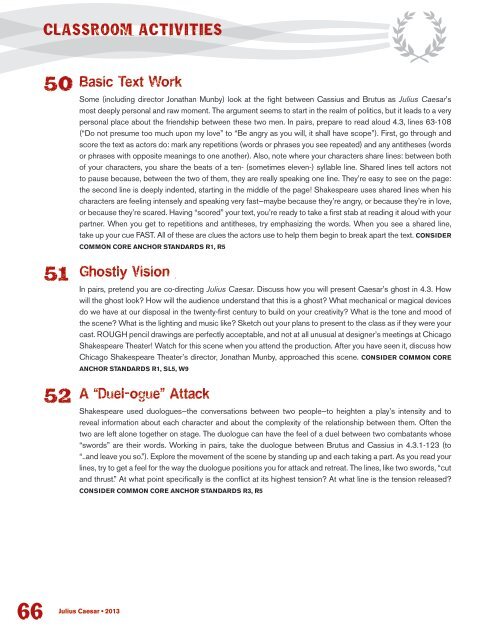Julius Caesar • 2013 - Chicago Shakespeare Theater
Julius Caesar • 2013 - Chicago Shakespeare Theater
Julius Caesar • 2013 - Chicago Shakespeare Theater
Create successful ePaper yourself
Turn your PDF publications into a flip-book with our unique Google optimized e-Paper software.
66<br />
CLASSROOM ACTIVITIES<br />
50<br />
51<br />
52<br />
Basic Text Work<br />
Some (including director Jonathan Munby) look at the fight between Cassius and Brutus as <strong>Julius</strong> <strong>Caesar</strong>’s<br />
most deeply personal and raw moment. The argument seems to start in the realm of politics, but it leads to a very<br />
personal place about the friendship between these two men. In pairs, prepare to read aloud 4.3, lines 63-108<br />
(“Do not presume too much upon my love” to “Be angry as you will, it shall have scope”). First, go through and<br />
score the text as actors do: mark any repetitions (words or phrases you see repeated) and any antitheses (words<br />
or phrases with opposite meanings to one another). Also, note where your characters share lines: between both<br />
of your characters, you share the beats of a ten- (sometimes eleven-) syllable line. Shared lines tell actors not<br />
to pause because, between the two of them, they are really speaking one line. They’re easy to see on the page:<br />
the second line is deeply indented, starting in the middle of the page! <strong>Shakespeare</strong> uses shared lines when his<br />
characters are feeling intensely and speaking very fast—maybe because they’re angry, or because they’re in love,<br />
or because they’re scared. Having “scored” your text, you’re ready to take a first stab at reading it aloud with your<br />
partner. When you get to repetitions and antitheses, try emphasizing the words. When you see a shared line,<br />
take up your cue FAST. All of these are clues the actors use to help them begin to break apart the text. CONSIDER<br />
COMMON CORE ANCHOR STANDARDS R1, R5<br />
Ghostly Vision<br />
In pairs, pretend you are co-directing <strong>Julius</strong> <strong>Caesar</strong>. Discuss how you will present <strong>Caesar</strong>’s ghost in 4.3. How<br />
will the ghost look? How will the audience understand that this is a ghost? What mechanical or magical devices<br />
do we have at our disposal in the twenty-first century to build on your creativity? What is the tone and mood of<br />
the scene? What is the lighting and music like? Sketch out your plans to present to the class as if they were your<br />
cast. ROUGH pencil drawings are perfectly acceptable, and not at all unusual at designer’s meetings at <strong>Chicago</strong><br />
<strong>Shakespeare</strong> <strong>Theater</strong>! Watch for this scene when you attend the production. After you have seen it, discuss how<br />
<strong>Chicago</strong> <strong>Shakespeare</strong> <strong>Theater</strong>’s director, Jonathan Munby, approached this scene. CONSIDER COMMON CORE<br />
ANCHOR STANDARDS R1, SL5, W9<br />
A “Duel-ogue” Attack<br />
<strong>Shakespeare</strong> used duologues—the conversations between two people—to heighten a play’s intensity and to<br />
reveal information about each character and about the complexity of the relationship between them. Often the<br />
two are left alone together on stage. The duologue can have the feel of a duel between two combatants whose<br />
“swords” are their words. Working in pairs, take the duologue between Brutus and Cassius in 4.3.1-123 (to<br />
“..and leave you so.”). Explore the movement of the scene by standing up and each taking a part. As you read your<br />
lines, try to get a feel for the way the duologue positions you for attack and retreat. The lines, like two swords, “cut<br />
and thrust.” At what point specifically is the conflict at its highest tension? At what line is the tension released?<br />
CONSIDER COMMON CORE ANCHOR STANDARDS R3, R5<br />
<strong>Julius</strong> <strong>Caesar</strong> <strong>•</strong> <strong>2013</strong>




